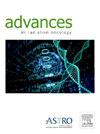Fifteen-Year Experience of a Single Institution: Outcomes for Early-Stage Hodgkins Lymphoma Comparing Chemotherapy Alone Versus Combined Modality Therapy
IF 2.2
Q3 ONCOLOGY
引用次数: 0
Abstract
Purpose
Doxorubicin, bleomycin, vinblastine, dacarbazine (ABVD) chemotherapy is the current standard treatment for early-stage Hodgkins lymphoma (HL). The use of consolidative radiation therapy (RT) in addition to chemotherapy may lead to better survival rates but is controversial because of concerns about long-term toxicity. The aim of this study is to compare outcomes of patients receiving ABVD chemotherapy alone (CTX alone) versus ABVD with consolidative RT (CMT).
Methods and Materials
A single-institution, retrospective review of patients with HL diagnosed from 2000 to 2014 was conducted. Patients were identified from the National Cancer Database. Inclusion criteria included patients aged ≥18 years, with stage I or II HL, who received ABVD with a complete response with/without CMT. Consolidative RT must have been started within 90 days of completing chemotherapy. Institutional review board approval was obtained. Follow-up details and treatment responses were collected from medical record reviews. Standard statistical analysis and Kaplan-Meier curves were used to estimate relapse-free survival (RFS).
Results
One hundred and 8 patients with early-stage HL were identified. The median age at diagnosis was 31 years (range, 19-72). Most patients were female (63%) and Caucasian (65%). stage II HL was present in 89%of patients, 89% had an Eastern Cooperative Oncology Group score of 0 or 1, 35% had B symptoms, and 9% had extranodal involvement. A total of 52.8% received CMT (n = 57) and 47.2% received CTX alone (n = 51). The CMT group had fewer cycles of chemotherapy compared to the CTX-alone group (mean cycles, 5.2 vs 5.7, P = 0.045). Twenty-four relapse events occurred in the CTX-alone group, while no relapse events occurred in the CMT group. RFS at 10 years was significantly improved in the CMT group (100%) compared to CTX alone (47.4%, P < .0001; HR = .03, P < .001).
Conclusions
ABVD with consolidative RT was associated with improved RFS. Further studies of toxicity comparisons, advanced stages, and nonfavorable HL are warranted.
一家医疗机构十五年的经验:早期霍奇金淋巴瘤化疗与综合疗法的疗效比较
目的多柔比星、博来霉素、长春新碱、达卡巴嗪(ABVD)化疗是目前治疗早期霍奇金淋巴瘤(HL)的标准疗法。在化疗的基础上使用巩固性放疗(RT)可能会提高生存率,但由于对长期毒性的担忧而备受争议。本研究旨在比较单纯ABVD化疗(CTX)与ABVD加巩固性RT(CMT)患者的疗效。患者从国家癌症数据库中确认。纳入标准包括年龄≥18岁、Ⅰ期或Ⅱ期HL、接受ABVD治疗后获得完全缓解并伴有/不伴有CMT的患者。巩固性 RT 必须在完成化疗后 90 天内开始。已获得机构审查委员会批准。通过病历审查收集随访详情和治疗反应。采用标准统计分析和 Kaplan-Meier 曲线估算无复发生存期(RFS)。确诊时的中位年龄为 31 岁(19-72 岁)。大多数患者为女性(63%)和白种人(65%)。89%的患者为 II 期 HL,89%的患者在东部合作肿瘤学组的评分为 0 分或 1 分,35%的患者有 B 型症状,9%的患者有结节外受累。52.8%的患者接受了CMT治疗(57例),47.2%的患者仅接受了CTX治疗(51例)。与单用CTX组相比,CMT组的化疗周期较少(平均周期为5.2 vs 5.7,P = 0.045)。单用CTX组有24例复发,而CMT组无复发。与单用CTX组(47.4%,P < .0001;HR = .03,P < .001)相比,CMT组(100%)10年的RFS明显改善。有必要对毒性比较、晚期和非良性HL进行进一步研究。
本文章由计算机程序翻译,如有差异,请以英文原文为准。
求助全文
约1分钟内获得全文
求助全文
来源期刊

Advances in Radiation Oncology
Medicine-Radiology, Nuclear Medicine and Imaging
CiteScore
4.60
自引率
4.30%
发文量
208
审稿时长
98 days
期刊介绍:
The purpose of Advances is to provide information for clinicians who use radiation therapy by publishing: Clinical trial reports and reanalyses. Basic science original reports. Manuscripts examining health services research, comparative and cost effectiveness research, and systematic reviews. Case reports documenting unusual problems and solutions. High quality multi and single institutional series, as well as other novel retrospective hypothesis generating series. Timely critical reviews on important topics in radiation oncology, such as side effects. Articles reporting the natural history of disease and patterns of failure, particularly as they relate to treatment volume delineation. Articles on safety and quality in radiation therapy. Essays on clinical experience. Articles on practice transformation in radiation oncology, in particular: Aspects of health policy that may impact the future practice of radiation oncology. How information technology, such as data analytics and systems innovations, will change radiation oncology practice. Articles on imaging as they relate to radiation therapy treatment.
 求助内容:
求助内容: 应助结果提醒方式:
应助结果提醒方式:


